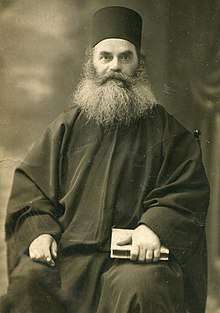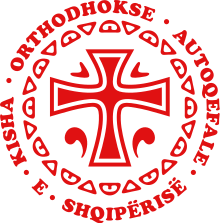Visarion Xhuvani
Metropolitan Visarion Xhuvani (14 December 1890 – 15 December 1965) was the primate of the Orthodox Autocephalous Church of Albania from 1929 to 1936. He was a main contributor to the autocephaly, and a close collaborator of Fan Noli.[1]
His Beatitude Vissarion | |
|---|---|
| Archbishop of Albania | |
 | |
| Installed | 20 February 1929 |
| Term ended | 26 May 1936 |
| Predecessor | Title created |
| Successor | Christopher (1937) |
| Personal details | |
| Birth name | Visarion Xhuvani |
| Born | 14 December 1890 Elbasan, Albania (then Ottoman Empire) |
| Died | 15 December 1965 (aged 75) Elbasan, Albania (then People's Republic of Albania) |
| Alma mater | Athens |
| Styles of The Archbishop of Tirana, Durrës and all Albania | |
|---|---|
 | |
| Reference style | His Beatitude |
| Spoken style | Your Beatitude |
| Religious style | Archbishop |
| Posthumous style | N/A |
Life
Visarion Xhuvani was born in the small Orthodox community in the "Kala" neighborhood of Elbasan, an old neighborhood inside the Elbasan Castle, in the Manastir Vilayet of the Ottoman Empire (present-day Albania). He was son of Joan and Efthimia,[2] a member of the prominent Xhuvani family, the same as the scholar and linguist Aleksandër Xhuvani.
He finished the elementary school in his home town, following with Rizarios Hieratical School in Athens. He studied theology in Athens afterwards. From 1919 to 1923 he served in Sofia, and after that for a short time in Cetin.
Xhuvani participated in the Congress of Lushnjë, December 1920, being elected senator.[3] He was a member of the Albanian parliament from 1919 to 1924.[3] During this time he cooperated with Noli, emphasizing the need for an Authocephalus Orthodox church in Albania, strongly opposing the Patriarchate of Constantinople attempts to keep the Orthodox community under the Greek influence and prohibit the Albanian language from being used in all ceremonies. He was a main contributor in the Orthodox Congress of 1922, where the Autocephaly of the Albanian Orthodox Church was proclaimed.[4]
Xhuvani was elected Primate of OACA in 1929, where King Zog pushed the Autochephaly as a priority of his state.[5][6] Despite the contradictions, Xhuvani served until 1937, the Church of Constantinople recognized the OACA, adding Xhuvani's removal as an ultimate condition. Xhuvani was forced to resign and was succeeded by Kristofor Kisi. Fan Noli would recall him as one of the most energetic clerics of Albania.[1] Beside Albanian, Xhuvani knew English, German, Romanian, Serbo-Croatian, Italian, and Old and New Greek languages. He has translated several theological studies into Albanian. He was the promoter of the Kristoforidhi's monument in the main plaza of Elbasan.
After the Italian invasion of Albania, he was part of the delegation which carried the Albanian throne to Victor Emanuel IIl in Rome. He was also elected member of the Constitutional Assembly of 1939.[3] During World War II he helped Jewish families by providing fake documents of Albanian nationality and citizenship[7] while serving as Bishop of Berat.
He was arrested by the Communists and imprisoned in 1946, condemned to 20 years on 22 December 1947, and released in 1963.[2] He died in Elbasan in 1965. He was initially buried in the St. Jovan Vladimir's Church in the nearby village of Shijon, being displaced later into the village's community cemetery.
Orthodox Autocephalous Church of Albania
Xhuvani's contribution to the Autocephaly of the Albanian Church was immense. He stands right by Noli on this point of view.
The Autocephalic Orthodox Church was proclaimed in Berat, on September 12, 1922 with four metropolitans, two seminaries, and twenty nine monasteries. It was not recognized by the Patriarchate in Constantinople which continued to insist Greek was used as language of the liturgy. Despite Noli's attempts taking advantage even of his engagement in politics there was no success in consecrating Albanian bishops. Therefore, the Albanian Church turned versus the Patriarchate of Peć which agreed to consecrate them instead. Xhuvani was consecrated bishop in Kotor, Kingdom of Slovenes, Croats, and Serbs from Russian Orthodox Church Outside Russia, residing in Sremski Karlovci.[5] He kept good relations with the Serbian church and authorities.[8]
The Patriarch of Constantinople declared that the process was invalid on their point of view.[9] Xhuvani would take over after Noli's exile and continue on the same path with persistence. As a countermeasure to Greek pressure, the Albanians expelled the bishop Hierotheos and imprisoned the other bishop Kristofor in a monastery, both elected from Constantinople. The relations were frozen for some time due to Xhuvani's strong oppositions to granting any requests to the Greek side. He was considered "an obstacle for the agreement" even from the Albanian government. The Churches of Constantinople and the one of Moscow didn't recognize the Autocephaly, while the Serbian Orthodox Church and the Romanian one recognized it in silence.
New negotiations started in 1935, finalizing on 1937 with the recognition of the Autocepalic Church of Albania by Patriarch Benjamin I of Constantinople. The Albanian side proposed Kristofor Kisi while the Greek side proposed Eulogios Kourilas, an Albanian from Ziçisht[5] with a very strong pro-Greek background. The delegation from Albanian government (including Koço Kota and Josif Kedhi) agreed on Kurilla's and Kotokos' presence under Kisi's hierarchy, in contradiction with what Xhuvani insisted. Xhuvani was constrained to resign but continued serving the Orthodox church in Albania.[10]
Further reading
- Vepra: për Kishën Ortodokse Shqiptare ; në kuvendin e Shqipërisë ; për jetën dhe veprën [Work: for Albanian Orthodox Church; in Albanian Parliament; for life and work] - Visarion Xhuvani, Editors: Nos Kostaq Xhuvani, Pavli Haxhillazi, 2005, Shtëpia Botuese "55", ISBN 9789994356072
References
- Hyqmet Zane (2012-06-26), Visarion Xhuvani, Kryepeshkopi i parë i KOAKSH-it (in Albanian), Gazeta Republika, retrieved 2014-01-15
- Hyqmet Zane, Ca të vërteta për Visarion Xhuvanin [Some facts about Visarion Xhuvani] (in Albanian), Express
- - Republika e Shqipërisë KUVEND. Tiranë 2005
- Hilmi Kolgjegja (2010). Perla shqiptare. Toena.
Më 13 shtator 1922, Kongresi Ortodoks i Shqipërisë, mbledhur në Berat i përfaqësuar nga 33 delegatë, shpalli Autoqefale Kishën Ortodokse shqiptare dhe vendosi zhvillimin e meshës në gjuhën shqipe.
- La Civiltà Cattolica, Issues 3727-3732, IV, Nov 19, 2005, p. 343, ISSN 0009-8167
- Genc Myftiu (2000). Albania, a patrimony of European values: a short encyclopedia of Albanian history and cultural heritage. SEDA. p. 67. ASIN B001P9PYMY. OCLC 47297904.
- Apostol Kotani (2007). Shqiptaret dhe hebrenjte ne shekuj [Albanians and Hebrews through the centuries]. Shoqata e Miqësisë Shqipëri-Izrael. p. 86. ISBN 9789994335633.
- Balkanica, 37, Srpska Akademija Nauka i Umetnosti, Balkanolos̆ki Institut, 2007, p. 257, ISSN 0350-7653, OCLC 85449734
- Robert Elsie (December 1, 2000). A Dictionary of Albanian Religion, Mythology, and Folk Culture. NYU Press. p. 198. ISBN 978-0814722145.
- Nos Xhuvani, Pavli Haxhillazi (2011-05-21), Dinakëria greke dhe kisha Ortodokse Shqiptare (in Albanian), Zemra Shqiptare, retrieved 2014-01-15,
...Mbreti Zog, kërkoi njohjen e autoqefalisë nga Patriarkana, duke dërguar Koço Kotën e Josif Kedhin në krye të një delegacioni pranë Patriarkut për t'i dhënë Tomusin Kishës Ortodokse Shqiptare. Kërkesave të Patriarkanës iu shtua edhe një kusht tjetër: largimi i Visarionit nga detyra e Kryeepiskopit. Visarioni, që dha kaq shumë për kishën tonë, vendosi të vetëflijohej dhe në Sinodin VII pranoi të jepte dorëheqjen. Mbas 27 majit të vitit 1936, dita kur dha dorëheqjen Visarioni, e deri më 12 prill të vitit 1937, pati veprimtari të dendur diplomatike për të bindur Patriarkun e Stambollit që të miratonte Tomusin. Ai nuk lëvizi nga kërkesat e veta, vetëm se i zbuti ato dhe ia përshtati diplomacisë së kohës, miratoi Tomusin dhe në krye të Kishës Shqiptare erdhi Imzot Kristofor Kisi...